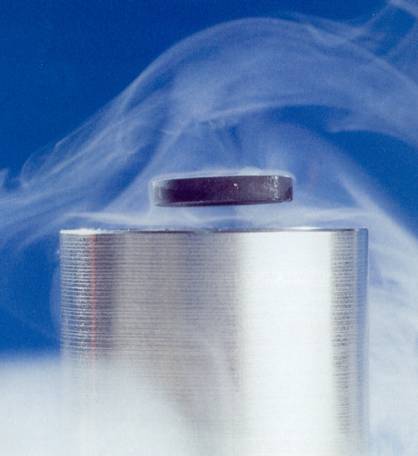Magnets are mainly characterized for having poles: if you put together poles of the same charge they repel and if you put together charges of different pole, they attract. A body will be under Magnetic Levitation when it floats due to that special repelling quality of the magnets, i.e. when the force generated by the electromagnetic repulsion is strong enough to balance the weight of the object.
Methods for Obtaining Magnetic Levitation
There are different methods for obtaining Magnetic Levitation. For heavy objects, the main are electromagnetic suspension and electrodynamic suspension. See: How does a Maglev Train work? for more details.
It has been proved that the levitation cannot be stable under static magnetism; there are several ways to overcome this problem, the use of diamagnetic materials is one. Diamagnetic substances repel the magnetic field; this effect can be used to create levitation of light objects. In particular superconducting substances are perfect diamagnets, allowing the lift of heavier weights.
Another mechanism is the use of eletrodynamic fields. Moving charges produce magnetism and moving magnets produce electricity; that is why both phenomena have been unified under the concept of electromagnetic field. Different arrays of moving conductors and/or magnets can be created to generate the stable vertical push needed for levitation.
Present Uses of Magnetic Levitation
MagLev Trains: Magnetic Levitation (Maglev) is famous by its uses in transportation, especially trains. Germany and Japan are pioneers in the development of MagLev trains. Japan and China have commercial MagLev trains in use at the moment.
MagLev Toys: Originally developed as laboratory experiences, some Magnetic Levitating objects have been released in the market as Hi Tech toys for kids of all ages. At the moment you can find:
- Toy MagLev trains and rails: A full kit with train and tracks can be found. Assembly is necessary and some patience, but the sight of the train speeding while floating over the track seems to worth the effort.
- Suspended objects: Clocks, golf balls, picture frames, collection cars, plains, globes and other objects can be found floating in mid air thanks to Magnetic Levitation technology.
Future Trends in Magnetic Levitation
MagLev Cars: Some research groups are working hard on the development of pure electrically driven rotors with the aim of freeing the vehicles of the rail that is necessary now. In that case they would have the key to develop flying cars.
MagLev Catapults: NASA is working on a catapult based on MagLev to reduce the cost and problems of launches of space aircrafts. The project is being done in partnership with the Navy which is interested in easier launches of aircrafts from the deck of a carrier.
MagLev HiFis: Some efforts are being explored in relation of Hi-Fi equipment for cars. They are trying to implement MagLev technology to keep the consoles in suspension and reduce vibration problems.
MagLev Elevators: Japan is planning to open in 2008 the first MagLev elevator in Tokio.




danish
is there is any use of Magnetic Levitation in airplane or space industry
RD
Of course there is! But, it will tear a hole in your wallet
manas
maglev,a very powerful concept which can be responsible to create the so called ‘futuristic’ world,system which has no friction can ensure enough perfect results!will love to see its implementation in india!
John Munoz
I received a floating mag lev globe for Christmas. It worked beautifully floating and turning on its axis. The other night the house lost power. The globe fell and attached to the stand. I repositioned the globe and now it floats but no longer spins. Any ideas or explanations? Thanks
RD
spin it with your hand